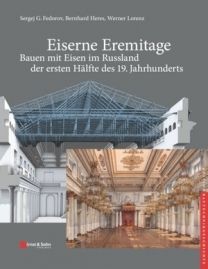About the book
In December 1837 a devastating fire destroyed the Winter Palace in St Petersburg - the seat of power of the Russian Empire. Tsar Nicolas I`s insistence on immediate restoration was the prelude to a monumental programme of renovation and reconstruction involving virtually every building within the imperial residence complex, known colloquially today as the Hermitage. Ostensibly "fire-proof" iron structures built using cutting-edge techniques replaced the traditional timber roofs and ceilings. By 1852 the largest assembly of iron supporting structures in the first half of the 19th century had been erected on an unprecedented scale and in an astonishing array of different designs - the Iron Hermitage.
Constructed in an era that was open to new technologies, when Europe was beginning to explore the possibilities of building with iron and to formulate initial rules and codes of practice, the iron structures concealed behind the facades and suspended ceilings of the Hermitage provide a unique testimony to the early days of European steel construction.
The fruits of a research project spanning several years, this two-volume monograph sheds remarkable new light on this world-class building complex: never before has a historic iron construction been captured, documented and interpreted in such breadth and depth as this. The study illustrates what a building research project with a strong engineering focus can achieve when it combines an evaluation of extensive archive collections and in situ investigations with laboratory and structural analyses, while at the same time placing them expertly within a contemporary and historical construction context. One volume of plates consists of archive documents, detailed architectural drawings and visualisations of the iron support structures selected from the wealth of material, complete with commentary.
When researching the history of iron construction and design and seeking further explanations, the authors traced the iron's long journey back to its roots in the iron ore mines and smelting furnaces of the Urals. This detective work uncovered the background which enabled the Iron Hermitage to be constructed in the first place - the impressive history of Russian iron production and hitherto virtually unknown pioneering achievements in iron construction in the 18th and early 19th century. The results change our understanding of the early history of steel construction by providing insights into the planning, design and construction processes of such a major project, and especially by unearthing Russia's time-honoured tradition of iron construction.



